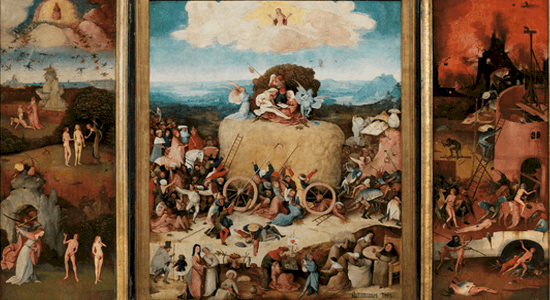Next year we celebrate the 500th anniversary of Martin Luther posting his Ninety-Five Theses. In this episode of 5 Minutes in Church History, Dr. Stephen Nichols considers the 500th anniversary of 1516.
The year 2017 marks the five-hundredth anniversary of the start of the Protestant Reformation, when Martin Luther posted his Ninety-Five Theses on October 31, 1517. But before 2016 ends, it is worthwhile to talk about the five-hundredth anniversary of 1516. That year set the stage for the start of the Reformation.
We can look at three things from the year 1516. This first is a painting. It’s called the Haywain Triptych; it was painted by the Dutch Renaissance painter Hieronymus Bosch. He was born in 1450 and died in 1516. This painting was one of his last major works.

A triptych is a painting with three panels; they were usually installed on altars. The two end panels would open and close, and painters would often paint the outside of these panels as well. On the outside of the Haywain Triptych is a painting that Bosch called The Wayfarer. It depicts a man who is trying to make his way through what is apparently a rather rough pilgrimage. He is being chased by dogs, and in the background you see a man being robbed and people fighting. This panel is meant to show that things were not all that rosy in 1516. As you open the panels, you see that things get even worse. The left panel depicts creation; as you work your way down the panel, you see God creating Adam and Eve, and then you see Eve being tempted, and you know where that’s going to lead. At the bottom of the panel, you see Adam and Eve being expelled from the garden. The far right panel depicts judgment and the torments of hell.
The center panel is fascinating, and it is what gives the triptych its name. In the middle of the center panel is a haywain, or hay wagon, upon which there is a very large hay bale. And on top of this hay bale, curiously enough, is an angel that is pointing upward. In the sky is Christ, and He is looking down on a group of people. But none of the people are looking up—they are not noticing Christ at all. They are trying to pluck some hay off of the wagon. You see a number of people in the background who are obviously poor and destitute, and they are being kept from the hay. It’s as if the nobility is keeping the masses away from these material benefits. And you also see, in the foreground, church officials who are enjoying an indulgent lifestyle. So, we go from creation and fall to judgment and in between is redemption, but it was being missed at this moment in the church’s history. So, Bosch’s Haywain Triptych portrays the great need of the people in 1516.
The second thing we could mention from 1516 is the Greek text. This, of course, is Erasmus’ Greek text. It was published in 1516 as the Novum Instrumentum Omne. It was actually a Greek text side by side with a Latin text, which was no easy feat to pull off with typesetting and printing, but that’s what Erasmus did at Basel, Switzerland. It took him more than a year to complete. Erasmus’ Greek text is important because it played a role in the Bible’s once again returning to the center of church life. The Bible has the solution for all those people in Bosch’s Haywain Triptych who are missing the solution to their ultimate problems in life.
The third thing we could mention from 1516 is that coffee was introduced to Europe from Arabia. So, 1516 tells us about our need through Bosch’s Haywain Triptych; it gives us the Greek text, which would provide the solution; and it gives us coffee, which would provide fuel for the theologians as they engaged the text and engaged the pressing theological issues of the time.
That’s 1516. All we need now is a courageous Augustinian monk who is ready to grab his mallet.
Stay connected with 5 Minutes in Church History by getting the weekly podcast on iTunes, SoundCloud, or via RSS. You can also subscribe to the blog via RSS and follow us on Twitter and Facebook.
(This podcast is by Ligonier Ministries. Discovered by e2 media network and our community — copyright is owned by the publisher, not e2 media network, and audio is streamed directly from their servers.)
